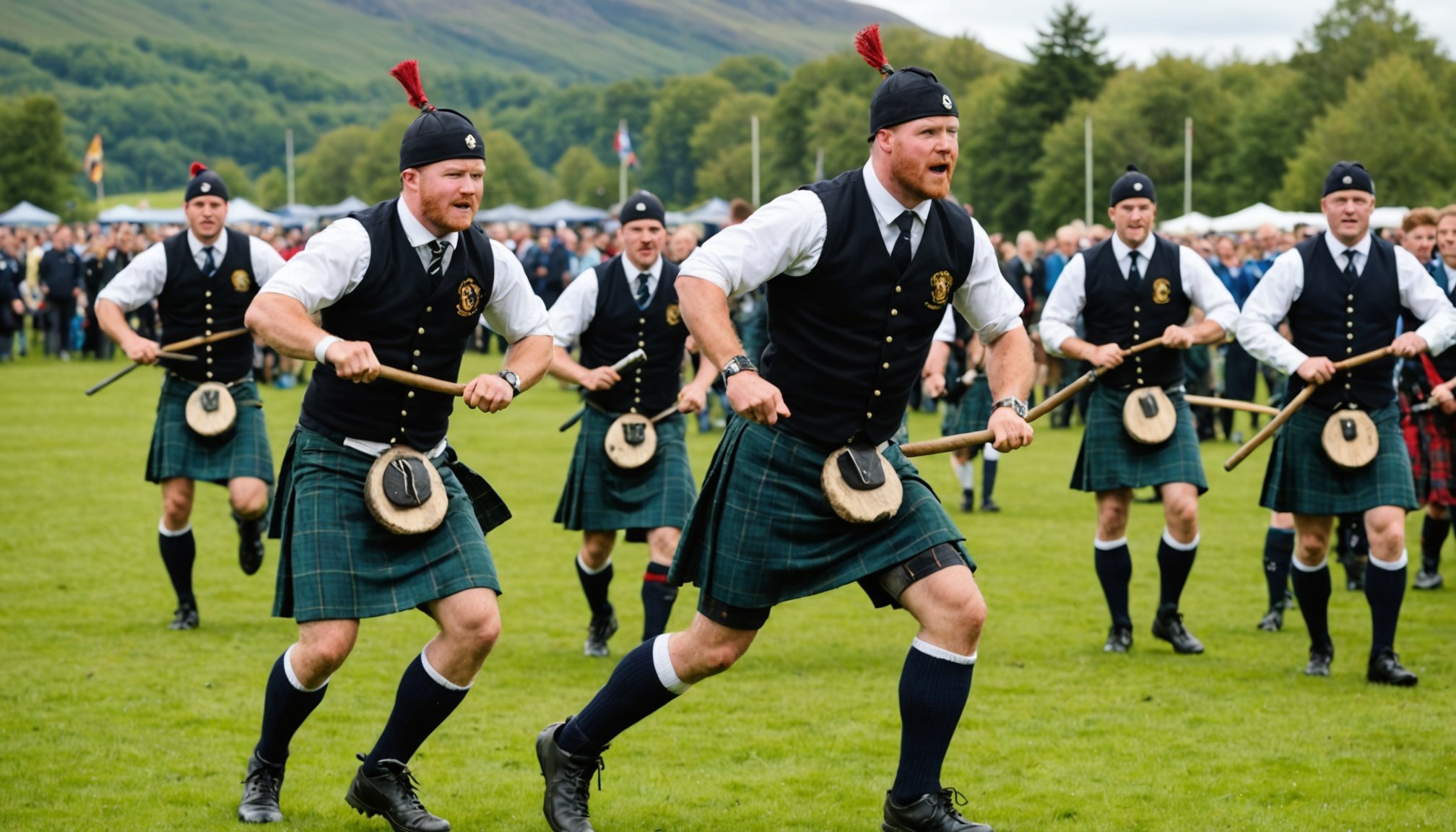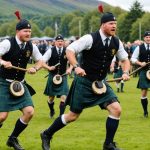Scotland's Highland Games combine athleticism, tradition, and community spirit in an exhilarating celebration of heritage. Experience the thrill of caber tossing and tug-of-war amid stunning landscapes. Whether you're a seasoned enthusiast or a curious first-timer, the vibrant atmosphere and rich history offer something for everyone. Explore the deeper significance of these events, uncover local customs, and learn how these games foster connections within communities. Ready for an adventure? Grab your kilt and dive into the excitement of Scotland's cherished tradition!
Overview of Scotland's Highland Games
The Highland Games are a celebrated tradition in Scotland, embodying a rich tapestry of history and culture. Originating in the 11th century, these games were initially a test of strength and skill for clan warriors. Over time, they evolved into a festive gathering, preserving the spirit of Scottish heritage through various traditional events.
This might interest you : How can you plan a heritage railway journey through the English countryside?
At the heart of the Highland Games are key events that showcase physical prowess and agility. The caber toss, where participants flip a large wooden log, is perhaps the most iconic. Other competitions include the stone put and hammer throw, each demanding exceptional strength. These events not only entertain but also honour the skills once vital for survival in the rugged Scottish Highlands.
Cultural importance is woven into the fabric of the Highland Games, reflecting the deep-rooted community involvement. These gatherings are more than just athletic contests; they are a celebration of Scottish identity, featuring traditional music, dance, and attire. Communities across Scotland and beyond come together, fostering a sense of unity and pride. The Highland Games serve as a vibrant reminder of Scotland's enduring traditions, drawing locals and visitors alike into a shared cultural experience.
Also to see : Discover stunning travel posters to elevate your decor
Major Events and Competitions
The Highland Games feature a variety of athletic competitions that captivate audiences with their unique blend of tradition and skill. These events not only test the physical limits of participants but also engage spectators with their thrilling displays.
Caber Tossing
Caber tossing is perhaps the most iconic event, where competitors must lift and flip a massive wooden log, known as a "caber." The goal is to toss the caber so it lands in a straight line, ideally at the 12 o'clock position. This event demands immense strength and precision, making it a favourite among both participants and spectators. Notable athletes have set impressive records, showcasing their prowess in this challenging competition.
Tug of War
The tug of war is a classic test of teamwork and strength. Teams compete by pulling on opposite ends of a rope, aiming to drag their opponents across a designated line. This event is not only a physical challenge but also a strategic one, requiring coordination and unity. The excitement of the tug of war often draws enthusiastic cheers from the crowd, adding to the lively atmosphere.
Hammer Throw
In the hammer throw, athletes swing a heavy weight attached to a handle and release it for maximum distance. The event highlights the competitors' strength and technique, with each throw a spectacle of power and skill. Audience engagement is high as they eagerly await each throw, contributing to the event's dynamic energy.
Travel Guide to Highland Games
Planning a visit to the Highland Games in Scotland involves strategic timing and preparation. The best time to experience these vibrant events is during the summer months, typically from May to September, when most games take place. This period not only offers pleasant weather but also a packed schedule of events across the country.
Key locations for the Highland Games include Braemar, Inverness, and Cowal, with each venue offering a unique experience. Braemar is renowned for its royal patronage, while Cowal hosts one of the largest gatherings. Inverness provides a picturesque setting in the heart of the Highlands, making it a must-visit for enthusiasts.
When planning your trip, consider booking accommodations well in advance, especially in popular areas like Edinburgh and Glasgow, which serve as gateways to the games. Look for local bed and breakfasts or hotels that offer easy access to the venues. For transportation, renting a car provides flexibility, but public transport is also a viable option, with trains and buses connecting major cities to game locations.
By keeping these travel tips in mind, you can ensure a seamless and enjoyable experience at the Highland Games.
Participating in the Highland Games
Becoming a participant in the Highland Games is a thrilling opportunity to engage with Scottish culture and test your physical limits. Aspiring athletes often begin their journey by joining local athletic clubs, which offer invaluable training and support. These clubs provide access to experienced trainers who guide participants through the rigorous preparation needed for events like the caber toss and hammer throw.
Training is a crucial part of the athlete experience, focusing on building strength, endurance, and technique. Prospective participants should incorporate a mix of weightlifting, cardio, and skill-specific exercises into their routines. For example, practicing with lighter logs can help athletes develop the precision required for the caber toss. Consistency and dedication are key to mastering these traditional sports.
Personal stories from past participants highlight the transformative nature of the Highland Games. Many athletes speak of the camaraderie and sense of achievement they gain from competing. One participant recounted the thrill of hearing the crowd cheer as they successfully flipped a caber for the first time. Such experiences not only enhance personal growth but also deepen one's connection to Scottish heritage, making participation in the Highland Games a truly rewarding endeavour.
Spectating the Highland Games
Attending the Highland Games as a spectator offers a vibrant mix of tradition, competition, and community spirit. The spectator experience is enriched by the thrilling displays of athleticism and the lively atmosphere that surrounds the events.
To make the most of your visit, consider these viewing tips. Arrive early to secure the best spots, especially for popular events like the caber toss and hammer throw. The front rows provide an up-close view of the action, while elevated areas offer a broader perspective of the entire field.
The Highland Games are inherently family-friendly, with plenty of activities to keep all ages entertained. Children can enjoy traditional Scottish music and dance performances, while family-friendly zones often feature games and crafts that engage younger audiences.
In addition to the athletic events, explore the cultural stalls and food vendors offering local delicacies. These elements add depth to the experience, allowing spectators to immerse themselves in Scottish culture.
Whether you're a first-time visitor or a seasoned attendee, the Highland Games promise an unforgettable day filled with excitement, tradition, and community celebration.
Cultural Insights and Traditions
The Highland Games are a vibrant reflection of Scottish culture, steeped in ancient traditions and rich clan heritage. These events are a tapestry of history, where the past is celebrated through various cultural expressions.
Clans play a significant role in the Highland Games, embodying the spirit and unity of Scottish heritage. Each clan brings its unique identity, often represented through tartans and emblems. During the games, clans come together to honour their ancestors and celebrate their shared history, fostering a sense of pride and belonging.
Traditional music and dance performances are integral to the celebration, offering a captivating glimpse into Scotland's artistic heritage. The stirring sounds of bagpipes and the rhythmic beat of drums set the tone for the festivities. Dancers, adorned in traditional attire, perform lively reels and jigs, captivating audiences with their grace and energy. These performances are not just entertainment; they are a tribute to Scotland's enduring cultural legacy.
The Highland Games serve as a living museum of Scottish traditions, where visitors can immerse themselves in the sounds, sights, and stories of a proud and resilient culture.
Visual Highlights of Highland Games
Visual content, such as images and videos, plays a crucial role in capturing the essence of the Highland Games. These visual highlights allow spectators to relive the excitement and share the vibrant atmosphere with others. For those unable to attend in person, recommended resources like official event websites and social media platforms offer a plethora of visual content. These platforms provide a window into the games, showcasing the dynamic events and cultural festivities.
The importance of visuals extends beyond mere documentation; they encapsulate the spirit and energy of the games. Through images, one can appreciate the precision of a caber toss mid-air or the collective effort during a tug of war. Videos, on the other hand, bring the sounds and movements of traditional music and dance to life, offering an immersive experience.
Personal anecdotes often highlight memorable moments captured in visuals. For instance, a photograph of a participant's triumphant expression after a successful hammer throw can evoke a sense of achievement and camaraderie. These visual stories not only preserve memories but also inspire others to explore and appreciate the rich cultural heritage of the Highland Games.
Tips for Enjoying the Highland Games
Immersing yourself in the Highland Games requires understanding basic event etiquette and adhering to safety guidelines. Respectful behaviour enhances the experience for everyone. Applaud participants' efforts, even if they're not victorious, and maintain a friendly atmosphere by engaging positively with fellow spectators.
Safety is paramount. For spectators, remain within designated areas to avoid interfering with events. Participants should ensure their gear is secure and follow instructions from event officials to prevent accidents. It's crucial to stay hydrated, especially during warmer months, and to be mindful of weather conditions that might affect the games.
Comfort is key to enjoying the day. Wear layered clothing that accommodates changing weather. A waterproof jacket can be invaluable in Scotland's unpredictable climate. Sturdy shoes are recommended for navigating uneven terrain, and a hat or sunscreen will protect against sun exposure. Consider bringing a portable chair or blanket for comfort during longer events.
Following these guidelines ensures a safe and enjoyable experience. By respecting event etiquette and preparing adequately, you'll fully appreciate the vibrant atmosphere and rich traditions of the Highland Games.
Testimonials and Personal Stories
The Highland Games leave a lasting impression on both participants and spectators, with personal experiences often highlighting the event's profound community impact. Many attendees share stories of how these traditional games foster a sense of belonging and pride in their Scottish heritage.
Participant stories frequently reveal the camaraderie and personal growth achieved through competition. One athlete recounted their first successful caber toss, describing the rush of adrenaline and the crowd's enthusiastic applause. Such experiences not only boost individual confidence but also strengthen community ties, as local clubs rally behind their representatives.
Spectators, too, have memorable moments that underline the games' communal spirit. A family attending their first Highland Games was struck by the warmth and hospitality of the locals, who eagerly shared insights into the events and traditions. These interactions enrich the experience, offering a deeper connection to the cultural tapestry of Scotland.
The community impact of the Highland Games extends beyond the events themselves. Local economies benefit from the influx of visitors, while the preservation of cultural traditions fosters a shared sense of identity. These personal stories and testimonials collectively illustrate the enduring significance of the Highland Games in Scotland's cultural landscape.










